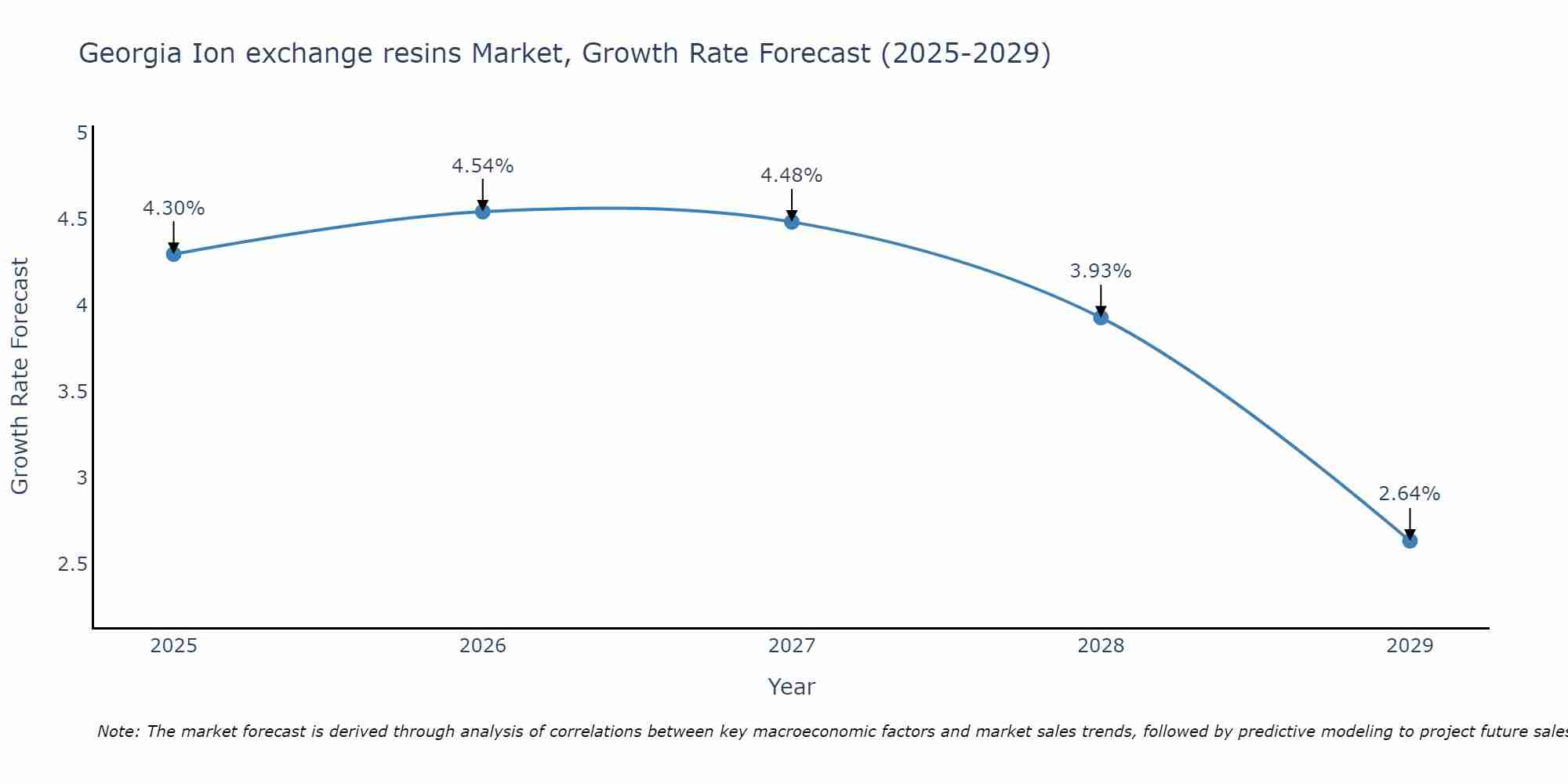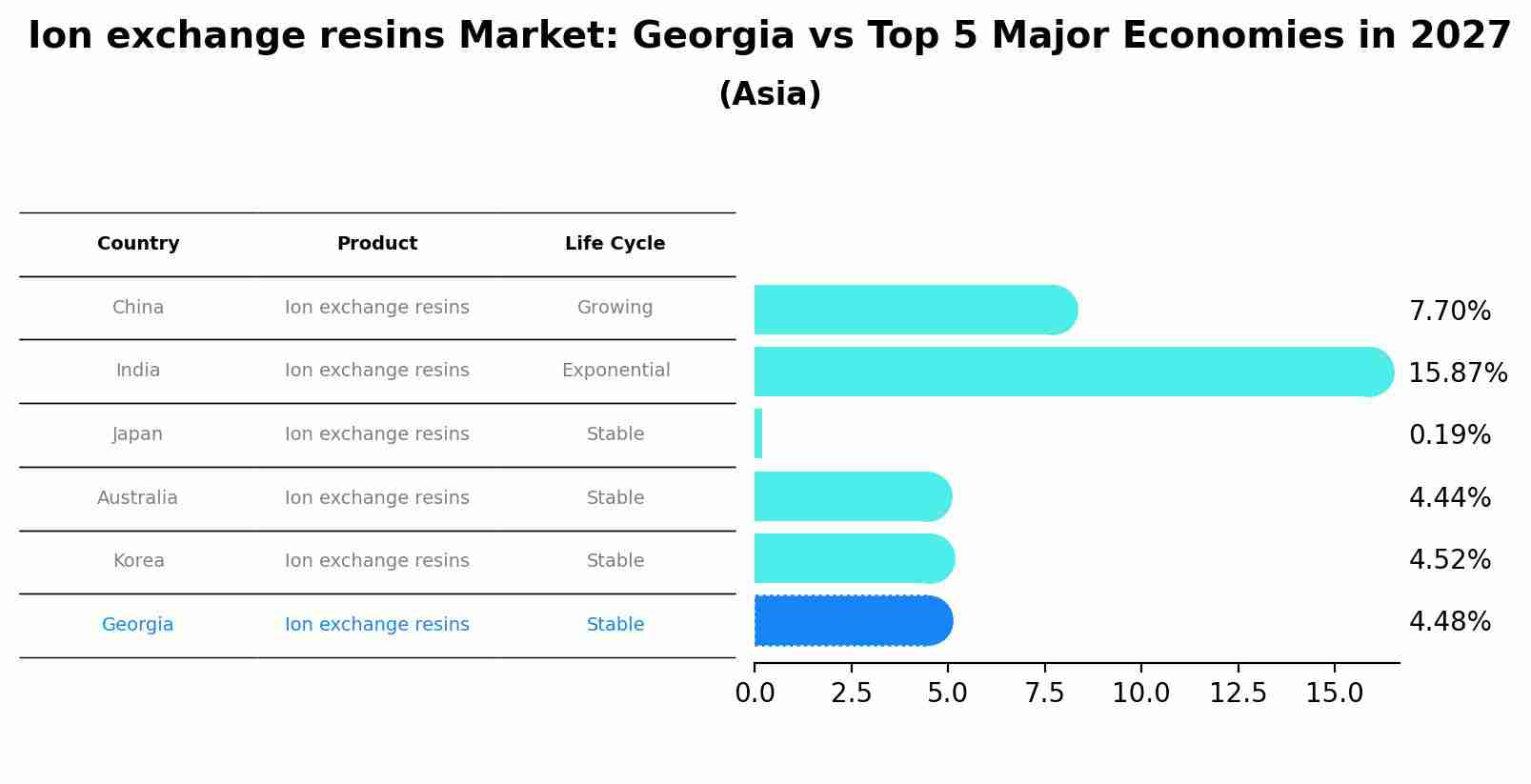Georgia Ion exchange resins Market (2025-2031) Outlook | Growth, Industry, Forecast, Companies, Analysis, Trends, Share, Value, Size & Revenue
| Product Code: ETC100699 | Publication Date: Jun 2021 | Updated Date: Apr 2025 | Product Type: Report | |
| Publisher: 6Wresearch | Author: Ravi Bhandari | No. of Pages: 70 | No. of Figures: 35 | No. of Tables: 5 |
Georgia Ion exchange resins Market Size Growth Rate
The Georgia Ion exchange resins Market is projected to witness mixed growth rate patterns during 2025 to 2029. Growth accelerates to 4.54% in 2026, following an initial rate of 4.30%, before easing to 2.64% at the end of the period.

Ion exchange resins Market: Georgia vs Top 5 Major Economies in 2027 (Asia)
Georgia's Ion exchange resins market is anticipated to experience a stable growth rate of 4.48% by 2027, reflecting trends observed in the largest economy China, followed by India, Japan, Australia and South Korea.

Georgia Ion exchange resins Market Overview
In Georgia, the ion exchange resins market is witnessing steady growth due to the rising demand from sectors like water treatment, pharmaceuticals, and food & beverage. Ion exchange resins play a crucial role in purifying water, removing contaminants, and facilitating various chemical processes. With increasing concerns over water quality and environmental regulations, the demand for ion exchange resins is expected to continue growing in Georgia, driven by their effectiveness and versatility in diverse applications.
Drivers of the market
With growing concerns over water quality and the need for effective water treatment solutions, the ion exchange resins market in Georgia is witnessing significant growth. Stringent regulations regarding water purity and the expansion of industries such as pharmaceuticals, food and beverages, and power generation are driving the demand for ion exchange resins.
Challenges of the market
The Georgia ion exchange resins market confronts several hurdles as it endeavors to meet the demand for water treatment and purification solutions. One of the primary challenges is the fluctuating availability and cost of raw materials required for resin production. Factors such as changes in global resin prices, supply chain disruptions, and regulatory restrictions can significantly impact the cost and availability of ion exchange resins in Georgia. Additionally, the market faces competition from alternative water treatment technologies, posing a challenge to widespread adoption. Moreover, issues related to resin fouling, regeneration efficiency, and waste disposal present ongoing challenges for users seeking effective and sustainable water treatment solutions in Georgia.
Government Policy of the market
In recognition of the importance of water purification and environmental sustainability, the Georgia government has implemented policies to promote the use of ion exchange resins. These policies include stringent regulations on water quality standards, subsidies for wastewater treatment facilities utilizing ion exchange technology, and research grants to support innovation in resin manufacturing processes.
Key Highlights of the Report:
- Georgia Ion exchange resins Market Outlook
- Market Size of Georgia Ion exchange resins Market, 2024
- Forecast of Georgia Ion exchange resins Market, 2031
- Historical Data and Forecast of Georgia Ion exchange resins Revenues & Volume for the Period 2021-2031
- Georgia Ion exchange resins Market Trend Evolution
- Georgia Ion exchange resins Market Drivers and Challenges
- Georgia Ion exchange resins Price Trends
- Georgia Ion exchange resins Porter's Five Forces
- Georgia Ion exchange resins Industry Life Cycle
- Historical Data and Forecast of Georgia Ion exchange resins Market Revenues & Volume By Type for the Period 2021-2031
- Historical Data and Forecast of Georgia Ion exchange resins Market Revenues & Volume By Cationic Resins for the Period 2021-2031
- Historical Data and Forecast of Georgia Ion exchange resins Market Revenues & Volume By Anionic Resins for the Period 2021-2031
- Historical Data and Forecast of Georgia Ion exchange resins Market Revenues & Volume By Others for the Period 2021-2031
- Historical Data and Forecast of Georgia Ion exchange resins Market Revenues & Volume By Application for the Period 2021-2031
- Historical Data and Forecast of Georgia Ion exchange resins Market Revenues & Volume By Water for the Period 2021-2031
- Historical Data and Forecast of Georgia Ion exchange resins Market Revenues & Volume By Non-water for the Period 2021-2031
- Historical Data and Forecast of Georgia Ion exchange resins Market Revenues & Volume By End-use Industry for the Period 2021-2031
- Historical Data and Forecast of Georgia Ion exchange resins Market Revenues & Volume By Power for the Period 2021-2031
- Historical Data and Forecast of Georgia Ion exchange resins Market Revenues & Volume By Chemical & Petrochemical for the Period 2021-2031
- Historical Data and Forecast of Georgia Ion exchange resins Market Revenues & Volume By Food & Beverage for the Period 2021-2031
- Historical Data and Forecast of Georgia Ion exchange resins Market Revenues & Volume By Pharmaceutical for the Period 2021-2031
- Historical Data and Forecast of Georgia Ion exchange resins Market Revenues & Volume By Electrical & Electronics for the Period 2021-2031
- Historical Data and Forecast of Georgia Ion exchange resins Market Revenues & Volume By Metal & Mining for the Period 2021-2031
- Historical Data and Forecast of Georgia Ion exchange resins Market Revenues & Volume By Others for the Period 2021-2031
- Georgia Ion exchange resins Import Export Trade Statistics
- Market Opportunity Assessment By Type
- Market Opportunity Assessment By Application
- Market Opportunity Assessment By End-use Industry
- Georgia Ion exchange resins Top Companies Market Share
- Georgia Ion exchange resins Competitive Benchmarking By Technical and Operational Parameters
- Georgia Ion exchange resins Company Profiles
- Georgia Ion exchange resins Key Strategic Recommendations
Frequently Asked Questions About the Market Study (FAQs):
1 Executive Summary |
2 Introduction |
2.1 Key Highlights of the Report |
2.2 Report Description |
2.3 Market Scope & Segmentation |
2.4 Research Methodology |
2.5 Assumptions |
3 Georgia Ion exchange resins Market Overview |
3.1 Georgia Country Macro Economic Indicators |
3.2 Georgia Ion exchange resins Market Revenues & Volume, 2021 & 2031F |
3.3 Georgia Ion exchange resins Market - Industry Life Cycle |
3.4 Georgia Ion exchange resins Market - Porter's Five Forces |
3.5 Georgia Ion exchange resins Market Revenues & Volume Share, By Type, 2021 & 2031F |
3.6 Georgia Ion exchange resins Market Revenues & Volume Share, By Form, 2021 & 2031F |
3.7 Georgia Ion exchange resins Market Revenues & Volume Share, By End-use Industry, 2021 & 2031F |
4 Georgia Ion exchange resins Market Dynamics |
4.1 Impact Analysis |
4.2 Market Drivers |
4.3 Market Restraints |
5 Georgia Ion exchange resins Market Trends |
6 Georgia Ion exchange resins Market, By Types |
6.1 Georgia Ion exchange resins Market, By Type |
6.1.1 Overview and Analysis |
6.1.2 Georgia Ion exchange resins Market Revenues & Volume, By Type, 2021-2031F |
6.1.3 Georgia Ion exchange resins Market Revenues & Volume, By Cationic Resins, 2021-2031F |
6.1.4 Georgia Ion exchange resins Market Revenues & Volume, By Anionic Resins, 2021-2031F |
6.1.5 Georgia Ion exchange resins Market Revenues & Volume, By Others, 2021-2031F |
6.2 Georgia Ion exchange resins Market, By Application |
6.2.1 Overview and Analysis |
6.2.2 Georgia Ion exchange resins Market Revenues & Volume, By Water, 2021-2031F |
6.2.3 Georgia Ion exchange resins Market Revenues & Volume, By Non-water, 2021-2031F |
6.3 Georgia Ion exchange resins Market, By End-use Industry |
6.3.1 Overview and Analysis |
6.3.2 Georgia Ion exchange resins Market Revenues & Volume, By Power, 2021-2031F |
6.3.3 Georgia Ion exchange resins Market Revenues & Volume, By Chemical & Petrochemical, 2021-2031F |
6.3.4 Georgia Ion exchange resins Market Revenues & Volume, By Food & Beverage, 2021-2031F |
6.3.5 Georgia Ion exchange resins Market Revenues & Volume, By Pharmaceutical, 2021-2031F |
6.3.6 Georgia Ion exchange resins Market Revenues & Volume, By Electrical & Electronics, 2021-2031F |
6.3.7 Georgia Ion exchange resins Market Revenues & Volume, By Metal & Mining, 2021-2031F |
7 Georgia Ion exchange resins Market Import-Export Trade Statistics |
7.1 Georgia Ion exchange resins Market Export to Major Countries |
7.2 Georgia Ion exchange resins Market Imports from Major Countries |
8 Georgia Ion exchange resins Market Key Performance Indicators |
9 Georgia Ion exchange resins Market - Opportunity Assessment |
9.1 Georgia Ion exchange resins Market Opportunity Assessment, By Type, 2021 & 2031F |
9.2 Georgia Ion exchange resins Market Opportunity Assessment, By Application, 2021 & 2031F |
9.3 Georgia Ion exchange resins Market Opportunity Assessment, By End-use Industry, 2021 & 2031F |
10 Georgia Ion exchange resins Market - Competitive Landscape |
10.1 Georgia Ion exchange resins Market Revenue Share, By Companies, 2024 |
10.2 Georgia Ion exchange resins Market Competitive Benchmarking, By Operating and Technical Parameters |
11 Company Profiles |
12 Recommendations |
13 Disclaimer |
- Single User License$ 1,995
- Department License$ 2,400
- Site License$ 3,120
- Global License$ 3,795
Search
Thought Leadership and Analyst Meet
Our Clients
Related Reports
- Germany Breakfast Food Market (2026-2032) | Industry, Share, Growth, Size, Companies, Value, Analysis, Revenue, Trends, Forecast & Outlook
- Australia Briquette Market (2025-2031) | Growth, Size, Revenue, Forecast, Analysis, Trends, Value, Share, Industry & Companies
- Vietnam System Integrator Market (2025-2031) | Size, Companies, Analysis, Industry, Value, Forecast, Growth, Trends, Revenue & Share
- ASEAN and Thailand Brain Health Supplements Market (2025-2031) | Strategy, Consumer Insights, Analysis, Investment Trends, Opportunities, Growth, Size, Share, Industry, Revenue, Segments, Value, Segmentation, Supply, Forecast, Restraints, Outlook, Competition, Drivers, Trends, Demand, Pricing Analysis, Competitive, Strategic Insights, Companies, Challenges
- ASEAN Bearings Market (2025-2031) | Strategy, Consumer Insights, Analysis, Investment Trends, Opportunities, Growth, Size, Share, Industry, Revenue, Segments, Value, Segmentation, Supply, Forecast, Restraints, Outlook, Competition, Drivers, Trends, Demand, Pricing Analysis, Competitive, Strategic Insights, Companies, Challenges
- Europe Flooring Market (2025-2031) | Outlook, Share, Industry, Trends, Forecast, Companies, Revenue, Size, Analysis, Growth & Value
- Saudi Arabia Manlift Market (2025-2031) | Outlook, Size, Growth, Trends, Companies, Industry, Revenue, Value, Share, Forecast & Analysis
- Uganda Excavator, Crane, and Wheel Loaders Market (2025-2031) | Strategy, Consumer Insights, Analysis, Investment Trends, Opportunities, Growth, Size, Share, Industry, Revenue, Segments, Value, Segmentation, Supply, Forecast, Restraints, Outlook, Competition, Drivers, Trends, Demand, Pricing Analysis, Competitive, Strategic Insights, Companies, Challenges
- Rwanda Excavator, Crane, and Wheel Loaders Market (2025-2031) | Strategy, Consumer Insights, Analysis, Investment Trends, Opportunities, Growth, Size, Share, Industry, Revenue, Segments, Value, Segmentation, Supply, Forecast, Restraints, Outlook, Competition, Drivers, Trends, Demand, Pricing Analysis, Competitive, Strategic Insights, Companies, Challenges
- Kenya Excavator, Crane, and Wheel Loaders Market (2025-2031) | Strategy, Consumer Insights, Analysis, Investment Trends, Opportunities, Growth, Size, Share, Industry, Revenue, Segments, Value, Segmentation, Supply, Forecast, Restraints, Outlook, Competition, Drivers, Trends, Demand, Pricing Analysis, Competitive, Strategic Insights, Companies, Challenges
Industry Events and Analyst Meet
Whitepaper
- Middle East & Africa Commercial Security Market Click here to view more.
- Middle East & Africa Fire Safety Systems & Equipment Market Click here to view more.
- GCC Drone Market Click here to view more.
- Middle East Lighting Fixture Market Click here to view more.
- GCC Physical & Perimeter Security Market Click here to view more.
6WResearch In News
- Doha a strategic location for EV manufacturing hub: IPA Qatar
- Demand for luxury TVs surging in the GCC, says Samsung
- Empowering Growth: The Thriving Journey of Bangladesh’s Cable Industry
- Demand for luxury TVs surging in the GCC, says Samsung
- Video call with a traditional healer? Once unthinkable, it’s now common in South Africa
- Intelligent Buildings To Smooth GCC’s Path To Net Zero


















